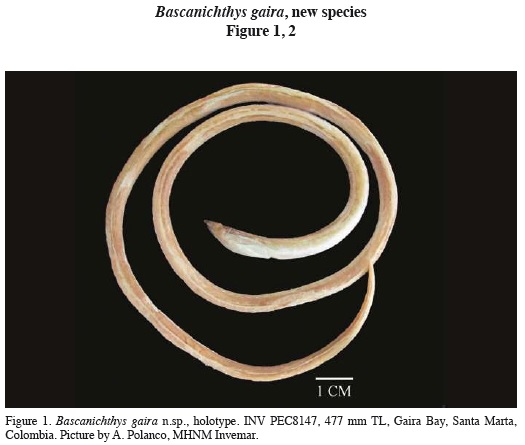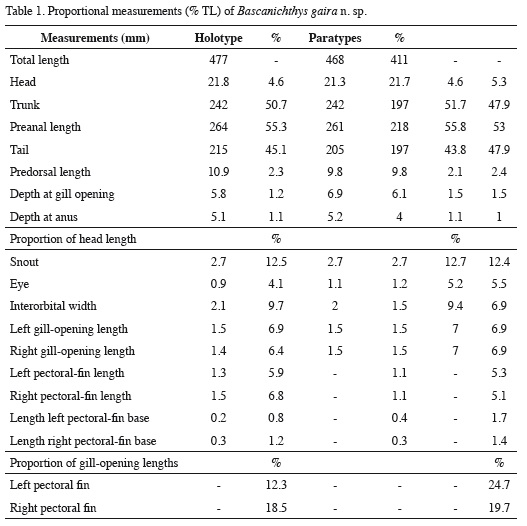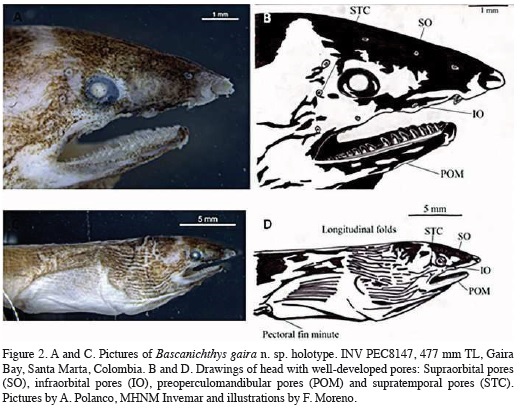Services on Demand
Journal
Article
Indicators
-
 Cited by SciELO
Cited by SciELO -
 Access statistics
Access statistics
Related links
-
 Cited by Google
Cited by Google -
 Similars in
SciELO
Similars in
SciELO -
 Similars in Google
Similars in Google
Share
Boletín de Investigaciones Marinas y Costeras - INVEMAR
Print version ISSN 0122-9761
Bol. Invest. Mar. Cost. vol.45 no.1 Santa Marta Jan./June 2016
A NEW SPECIES OF SAND EEL GENUS BASCANICHTHYS (ANGUILLIFORMES: OPHICHTHIDAE) FROM THE CARIBBEAN
UNA NUEVA ESPECIE DE ANGUILA DE ARENA DEL GÉNERO BASCANICHTHYS (ANGUILLIFORMES: OPHICHTHIDAE) DEL CARIBE
Fabián Moreno1, Arturo Acero P.2 and Marcela Grijalba-Bendeck3
1 Universidad Santo Tomás Villavicencio, Ciencias Básicas, Villavicencio, Colombia. fabianmorenor@usantotomas.edu.co
2 Universidad Nacional de Colombia Sede Caribe, Cecimar, El Rodadero, Santa Marta, Colombia. aacerop@unal.edu.co
3 Universidad de Bogotá Jorge Tadeo Lozano, Facultad de Ciencias Naturales e Ingeniería, Programa de Biología Marina, Grupo de Investigación Dinámica y Manejo de Ecosistemas Marino Costeros (DIMARCO), Mundo Marino, El Rodadero, Santa Marta, Colombia. marcela.grijalba@utadeo.edu.co
ABSTRACT
A new species of the sand eel genus Bascanichthys (Anguilliformes: Ophichthidae) is described from specimens found inside the stomachs of mature female numbfish Narcine bancroftii. These rays were collected as bycatch in local fisheries, using beach seines in shallow waters (5 to 10 m) in Gaira Bay (Santa Marta, Colombian Caribbean). Bascanichthys gaira n.sp., is described from three specimens and can be distinguished from other species of the genus by its minute pectoral-fin base (12.324.7% of gill-opening length) and its vertebral number (189).
KEY WORDS: Endemic sand eel, Anguilliformes, Ophichthidae, Colombia, Southern Caribbean.
RESUMEN
Nueva especie de anguila de arena del género Bascanichthys (Anguilliformes: Ophichthidae) es descrita a partir de ejemplares encontrados en el contenido estomacal de hembras maduras de la raya eléctrica Narcine bancroftii. Estas rayas fueron colectadas como parte del bycatch en las pesquerías locales, usando chinchorros playeros en aguas superficiales (5 a 10 m) de la bahía de Gaira (Santa Marta, Caribe colombiano). Bascanichthys gaira sp. n. es descrita a partir de tres ejemplares colectados y es fácilmente diferenciable de otras especies del mismo género debido a su diminuta aleta pectoral (su base representa entre 12.3-24.7% de la longitud de la apertura branquial) y su número de vértebras (189).
PALABRAS CLAVES: Anguila de arena endémica, Angulliformes, Ophichtidae, Colombia, Caribe sur.
INTRODUCTION
Snake eels of the family Ophichthidae are the most diverse of true eels, including 260 living species distributed among 58 genera in all tropical oceans and seas (McCosker, 2002; Nelson, 2006). Snake eels live in a variety of habitats, from sandy intertidal to midwater depths of 800 m (McCosker, 2002). Ophichthids have pelagic leptocephalus larvae. The adults live in a variety of environments, from coral reefs to sand and mud substrates, oceanic midwaters, and also in rivers and estuaries (McCosker et al., 1989). Some species are taken as bycatch of several types of fisheries, using trawl fisheries and hook-and-line, but they are rarely consumed (McCosker, 2002).
According to McCosker et al. (1989), Ophichthidae is currently divided into two subfamilies, Myrophinae (tribes Benthenchelyini and Myrophini) and Ophichthinae (including the tribes Bascanichthyini, Callechelyini, Ophichthini, and Sphagebranchini). The Bascanichthyini, sand eels, includes moderately small, very elongate, plain-coloured or banded species with hanging pointed snouts and anus at or behind the mid-body. They live buried in sand and mud from shallow to moderate depths. Sand eels are collected using ichthyocides in shallow waters, but are also captured by benthic and midwater trawling. The Bascanichthyini comprises eight genera, but only five are found in the western Atlantic, Bascanichthys, Caralophia, Ethadophis, Gordiichthys, and Phaenomonas (McCosker et al., 1989).
The family Ophichthidae is poorly known in the Colombian Caribbean, with only a few reports published, including Ichthyapus ophioneus (Evermann & Marsh 1900), Callechelys bilinearis Kanazawa 1952 (Acero and Garzón, 1986), and Ophichthus cylindroideus (Ranzani 1839) (Barrera-García et al., 2008). Species of Bascanichthys, the most primitive member of its tribe, inhabit sand, mud and silt bottoms; other features include an elongated body, cylindrical and compressed, head and trunk longer than the tail, dorsal fin originating on the head, median fins low, pectoral fins small, snout short and rounded, standing over the lower jaw, jaws short, eyes small, and anterior nostrils tubular (McCosker et al., 1989). Reaching a maximum size of about 1000 mm total length, they are distributed in all tropical seas with approximately 12 valid species, but only four are recognized in the western Atlantic, Bascanichthys bascanium (Jordan 1884), Bascanichthys inopinatus McCosker, Böhlke & Böhlke 1989, Bascanichthys paulensis Storey 1939, and Bascanichthys scuticaris (Goode and Bean 1880). Herein we present the original description of a new species of Bascanichthys based on three specimens obtained from the stomachs of Narcine bancroftii (Griffith and Smith) fished in Gaira bay, Colombian Caribbean.
MATERIAL AND METHODS
Three sand eel specimens were found inside the stomachs of three mature females (462 to 542 mm total length) of Bancroft's numbfish Narcine bancroftii. These rays were collected as bycatch in local fisheries using beach seines in shallow waters (5 to 10 m) at Gaira bay in Salguero beach, located toward south of Santa Marta, Colombian Caribbean (11º10'11"N, 74º13'14"W). In the laboratory the numbfish were dissected from the pectoral arch to the cloaca, their stomachs were extracted and the contents deposited in a Petri box and then washed with fresh water; afterward, the material was weighed with a digital scale and stored in 70% isopropyl alcohol. The eels were almost perfectly conserved, keeping most of their skin and coloration, thus digestion process had not damaged the main features of the specimens. Both the holotype and paratypes were deposited in the fish collection of the Marine Natural History Museum of the Marine and Coastal Research Institute (Invemar) under the reference INV PEC8147 holotype, INV PEC8146 and INV PEC8145 paratypes.
All counts and measurements were taken directly from specimens using a calliper. Measurement values were recorded to the nearest tenth (0.1) of a millimetre, following McCosker et al. (1989). The following measurements were taken: Total length (TL), straight-line distance between the anterior tip of the upper lip and posterior tip of the tail; head length (HL), straight-line distance between the anterior tip of the upper lip and posterior edge of the opercular flap; trunk length, straight-line distance from the posterior edge of the opercular flap to mid-anus; tail, straight-line distance between mid-anus and rear tip of the tail; predorsal length, straight-line distance from anterior tip of upper lip up to anterior margin of the dorsal fin; depth at gill opening, body depth behind the gill opening; gill opening length, straight-line distance between gill opening corners; depth at anus, body depth at mid-anus; snout, straight-line distance from anterior tip of upper lip to closest point on the anterior fleshy edge of the orbit; preanal length, straight-line distance from anterior tip of the upper lip to mid-anus; eye, horizontal diameter of the eye; inter-orbital width, straight-line distance between eyes; pectoral-fin length, distance between base and rear tip of the pectoral fin; pectoral-fin base, length of pectoral-fin base.
Pore numbers were expressed as follows: supraorbital pores (SO) as ethmoid pore + pores in supraorbital canal; infraorbital pores (IO) as pores along upper jaw + pores in the vertical part of the canal behind the eye (in general the last pore included along the upper jaw is considered one of the postorbital pores); preoperculomandibular pores (POM) as pores along the lower jaw + preopercular pores; supratemporal pores (STC) total number of pores in the supratemporal canal (McCosker et al., 1989). One paratype was used to count total, predorsal, and preanal vertebrae. All counts and measurements were compared with material of two species of the genus Bascanichthys, B. inopinatus (ANSP 158886 paratype) and B. paulensis (ANSP 156906, ANSP 158821 paratypes), and five additional species recorded in the bibliography from the western Atlantic and the Eastern Pacific coasts.
Material examined. Holotype, INV PEC8147 (477 mm TL), bahía de Gaira, Santa Marta, Colombia (11º10'11" N, 74º13'14" W), September 5, 2005. Paratypes, INV PEC8145 (468 mm TL) September 5, 2005, INV PEC8146 (411 mm TL) August 22, 2006, all from the same locality as the holotype: Bahía de Gaira, Santa Marta, Colombia (11º10'11" N, 74º13'14" W).
Diagnosis. An elongate, markedly bicolored bascanichthyin, dark brown dorsally and light brown almost cream ventrally, head and snout dark, fins pale without marks, sex unrecognized. Maximum total length 477 mm. Proportions as % of TL: head 4.6-5.3, trunk 47.9-51.7, tail 43.8-47.9; depth (at gill opening) 1.21.5; depth (at anus) 1-1.1; predorsal length 2.1-2.4; snout 12.4-12.7; eye 4.1-5.5; interorbital width 6.9-9.7; pectoral-fin length 6.4-7.0 mm; Pores SO 1 + 3, IO 4 + 2, POM 4 + 2, STC 3. Pectoral fin minute, its base corresponding to 12.3-24.7% of gill-opening length. Uniserial mandibular teeth (Table 1; Figure 2).
Description. Total vertebrae 189, predorsal vertebrae 1, preanal vertebrae 100. Elongate body, muscular and rounded, anus shortly behind midbody, longitudinal folds on head and gular region (Figure 2). Median fins developed but low, ending shortly before tail tip, pectoral fin minute, its base one-fourth the length of the gill openings, pectoral fin moderately long for Bascanichthys (3 to 6 times the length of its base), somewhat triangular and finishing in a filament. Head and jaws short, pointed snout overhanging lower jaw, eye small, located above half of the lower jaw, anterior nostril tubular, posterior nostril above midlength of upper jaw and without flap, visible externally as a small hole in the upper lip. Head pores small and well-defined (Figure 2). Gill openings moderate in size, vertical and low-lateral on side, dentition typical for the genus, three anterior intermaxillary large stout teeth describing an inverted "V" in a groove on the underside of the snout, exposed when the mouth is closed, 13 to 17 teeth along vomer, well-separated from conical and uniserial (13-14) intermaxillary and maxillary teeth.
Distribution. All the specimens were collected in Gaira Bay (11º10'11" N, 74º13'14" W), Santa Marta, Colombia, inside the stomach of mature females of Bancroft's numbfish Narcine bancroftii, fished as bycatch of the local beach seine fisheries.
Etymology. This species was named gaira in reference to Bahía de Gaira, where this species was captured. The proposed vernacular name "Colombian sand eel" refers to the fact that this species is the first record of the genus Bascanichthys from Colombia and the southern Caribbean.
Remarks. Type material was compared with museum specimens of B. inopinatus (ANSP 158886 paratype) and B. paulensis (ANSP 156906, ANSP 158821 paratypes) as well as with the descriptions of Neotropical species presented by McCosker et al. (1989) and Robertson et al. (2015). There were four described species of Bascanichthys from the western Atlantic: B. bascanium (Jordan 1884), B. inopinatus McCosker, Böhlke and Böhlke 1989, B. paulensis Storey 1939 and B. scuticaris (Goode and Bean 1880). Bascanichthys scuticaris differs from the new species by having a total of 159-167 vertebrae (vertebral count for B. gaira is 189). Other diagnostic characters of B. scuticaris, a species taken at coastal United States from North Carolina to the Gulf of Mexico, that differ from B. gaira are body marked by a series of small, pale spots above each lateral-line pore along body, tail, and branchial region; pore sequence: SO 1 + 3, IO 4 + 2, POM 4 + 2, ST 3 (McCosker et al., 1989). Bascanichthys gaira differs from the other three western Atlantic species B. bascanium, B. inopinatus, and B. paulensis) because pectoral fin in B. gaira is minute, its base corresponds to 12.3-24.7% of gill-opening length. In B. bascanium, a species reported from Georgia to Honduras, Puerto Rico, and a locality in Panamá, pectoral fin is broad-based and its width 44-47% length of gill opening (McCosker et al., 1989); it should be corroborated if the material from Panamá indeed coincides with B. bascanium or it agrees with the new species. In B. inopinatus, a species apparently endemic to Puerto Rico, pectoral fin base represents 36-37% of the length of gill opening; additionally, B. gaira differs from B. inopinatus in vertebrae counts (B. gaira has 189 total vertebrae, 1 predorsal vertebra, and 100 preanal vertebrae; B. inopinatus has 199, 1, and 101, respectively) and in the number of supraorbital pores (B. gaira has 1+3 SO, B. inopinatus 1+4 SO) (McCosker et al., 1989; Robertson et al., 2015). Bascanichthys gaira seems to be closer to B. paulensis, since both have similar vertebrae counts; in B. paulensis the total vertebrae range between 190 and 196, with one or two predorsal vertebrae and 100-103 preanal vertebrae. Pore numbers are the same in both species. The pectoral fin and base length are different; in B. paulensis the pectoral-fin base length range is between 25 and 33% of the gillopening length, while in B. gaira the pectoral fin base ranges from 12.3 to 24.7% of the gill-opening length. Bascanichthys paulensis has a very small and rounded pectoral fin, with a narrow base; although the pectoral fin of B. gaira is smaller, it is not rounded but somewhat triangular and finished in a filament.
In the Eastern Pacific B. gaira has three relatives: B. panamensis Meek and Hildebrand 1923, B. cylindricus Meek and Hildebrand 1923, and B. bascanoides Osburn and Nichols 1916 (Meek and Hildebrand, 1923). The main differences between them are the total number of vertebrae (total vertebrae 189, predorsal vertebrae 1, preanal vertebrae 100) and pectoral fin base/length ratio (12.3-24.7% of gill-opening length) (Tables 1 and 2).
Natural coloration of B. gaira is markedly bicolored, dark brown dorsally and light brown almost cream ventrally, head and snout dark, fins pale without marks. Colour in alcohol same that natural with some light zones in head and body.
ACKNOWLEDGEMENTS
To the Research Direction, the Marine Biology Program and the Facultad de Ciencias Naturales e Ingeniería, Universidad de Bogotá Jorge Tadeo Lozano for financial support of the project "Biological aspects of some batoids from Santa Marta, Colombian Caribbean" (315P). This is contribution 399 of the Instituto de Estudios en Ciencias del Mar (Cecimar), Universidad Nacional de Colombia sede Caribe.
LITERATURE CITED
Acero P., A. and J. Garzón. 1986. Peces de las islas del Rosario y de San Bernardo (Colombia) II. Tres nuevos registros para el Caribe sur y 16 más para la costa norte continental colombiana. An. Inst. Invest. Mar. Punta Betín, 15-16: 3-29. [ Links ]
Barrera-García, A., A. Acero P., C. Polo-Silva and M. Grijalba-Bendeck. 2008. Confirmación de la presencia de Ophichthus cylindroideus (Ranzani) (Anguilliformes: Ophichthidae) en el Caribe colombiano. Bol. Invest. Mar. Cost., 37 (2): 213-219. [ Links ]
McCosker, J.E. 2002. Ophichthidae. 724-733. En: Carpenter, K. (Ed.). The living marine resources of the Western Central Atlantic. FAO Species Identification Guide for Fishery Purposes and American Society of Ichthyologists and Herpetologists Special Publication, Vol. 5 Num. 3. Rome. 2127 p. [ Links ]
McCosker, J.E., E. Böhlke and J. Böhlke. 1989. Family Ophichthidae. 254-412. In: Fishes of the Western North Atlantic. Part 9. Orders Anguilliformes and Saccopharyngiformes. Sears Found. Mar. Res, 1. [ Links ]
Meek, S.E. and S.F. Hildebrand. 1923. The marine fishes of Panama. Field Museum of Natural History, Zoological Series, Chicago, 15(215): 330 p. [ Links ]
Nelson, J. 2006. Fishes of the world. John Wiley and Sons, Inc, Hoboken, USA. 601 p. [ Links ]
Robertson, D.R. and G.R. Allen. 2015. Shorefishes of the Tropical Eastern Pacific: online information system. Version 2.0 Smithsonian Tropical Research Institute, Balboa, Panamá. http://biogeodb.stri.si.edu/sftep/es/pages. [ Links ]
Robertson, D.R., E.A. Peña, J.M. Posada and R. Claro. 2015. Peces costeros del Gran Caribe: sistema de información en línea. Balboa, Panamá. http://biogeodb.stri.si.edu/caribbean/es/pages. [ Links ]
RECEIVED: 15/10/2014 ACCEPTED: 28/10/2015

















